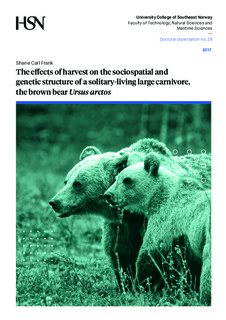| dc.contributor.author | Frank, Shane C. | |
| dc.date.accessioned | 2018-07-27T13:09:42Z | |
| dc.date.available | 2018-07-27T13:09:42Z | |
| dc.date.issued | 2017-10-20 | |
| dc.identifier.isbn | 978-82-7206-451-7 | |
| dc.identifier.issn | 2464-2843 | |
| dc.identifier.uri | http://hdl.handle.net/11250/2506689 | |
| dc.description.abstract | Understanding the effects of harvest is integral for sustainable wildlife management and conservation. And yet, the focus of managers has predominantly been on the direct mortality of harvest, often ignoring the indirect effects of harvest, such as those resulting from changes to sex, age, and social structure, the behavior of individuals, and the potential for human-induced selection. Such effects can influence population growth rate beyond that expected from direct mortality. This thesis reviewed the indirect effects of harvest on the Swedish brown bear population, explored the spatial reorganization of bears following harvest, examined whether the spatial reorganization of males can contribute to sexually-selected infanticide (SSI), and evaluated whether hunting has played a role in affecting fine-scale genetic structure of matrilines. The best documented indirect effect of bear harvest in Sweden is SSI. The disruption to social structures due to harvest causes a spatial reorganization in brown bears, seemingly as a result of competitive release from conspecifics. This is most pronounced among surviving individuals living in proximity of hunter-killed bears of the same-sex. These survivors consistently increased their use of the now vacant home ranges. Furthermore, the strength of spatial responses of surviving individuals during reorganization was modulated by the sex, pairwise relatedness, and age of surviving and killed bears, in addition to hunting intensity and population density. For males, their spatial reorganization is consistent with the time lag (~two years following harvest) of SSI found in other studies. We also found that harvest could contribute to the decrease in finescale genetic structure of brown bear matrilines. Fine-scale genetic structure is commonly used to identify important management units of wildlife populations. Female brown bears are socially and spatially organized in matrilines. It is unknown how alterations to FGS could affect the persistence of populations. In the case of the Scandinavian brown bear population, changes to FGS could be an indication of selective harvest, the redistribution of male reproductive success, altered dispersal patterns, and increased individual turnover associated with high hunting pressure. However, we provide empirical evidence that indirect effects of harvest exist, particularly through a spatial reorganization following harvest that can influence the risk of SSI. We suggest that managers of bear and other large carnivore populations apply the precautionary approach and assume that indirect effects do exist, which could have a potential impact on population structure and growth. | nb_NO |
| dc.language.iso | eng | nb_NO |
| dc.publisher | University College of Southeast Norway | nb_NO |
| dc.relation.ispartofseries | Doctoral dissertations at the University College of Southeast Norway;28 | |
| dc.relation.haspart | Paper I: Frank, S.C., Ordiz, A., Gosselin, J., Hertel, A., Kindberg, J., Leclerc, M., Pelletier, F., Steyaert, S.M.J.G., Støen, O.G., Van de Walle, J., Zedrosser, A., & Swenson J.E.: Indirect effects of bear hunting: a review from Scandinavia. Ursus 28(2), (2017), 150-164. Accepted version. The published version is available at https://doi.org/10.2192/URSU-D-16-00028.1 | nb_NO |
| dc.relation.haspart | Paper II: Frank, S.C., Leclerc, M., Pelletier, F., Rosell, F., Swenson, J.E., Bischof, R., Kindberg, J., Eiken, H.G., Hagen, S.B. & Zedrosser, A.: Sociodemographic factors modulate the spatial response of brown bears to vacancies created by hunting. Journal of Animal Ecology 87(1), (2018), 247-258. Accepted version. The published version is available at https://doi.org/10.1111/1365-2656.12767 | nb_NO |
| dc.relation.haspart | Paper III: Leclerc, M., Frank, S.C., Zedrosser, A., Swenson, J.E. & Pelletier, F.: Hunting promotes spatial reorganization and sexually selected infanticide. Scientific Reports 7 (2017). https://doi.org/10.1038/srep45222 | nb_NO |
| dc.relation.haspart | Paper IV: Frank, S.C., Pelletier, F., Bourret, A., Garant, D., Rosell, F., Swenson, J.E., Eiken, H.G., Hagen, S.B. & Zedrosser, A.: A smoking gun: hunting disrupts fine-scale genetic structure among matrilines of a large carnivore. Manuscript. | nb_NO |
| dc.rights.uri | http://creativecommons.org/licenses/by-nc-sa/4.0/deed.no | |
| dc.subject | hunting | nb_NO |
| dc.subject | social structure | nb_NO |
| dc.subject | spatial reorganization | nb_NO |
| dc.subject | brown bear | nb_NO |
| dc.subject | Ursus arctos | nb_NO |
| dc.subject | genetic structure | nb_NO |
| dc.subject | matriline | nb_NO |
| dc.title | The effects of harvest on the sociospatial and genetic structure of a solitary-living large carnivore, the brown bear Ursus arctos | nb_NO |
| dc.type | Doctoral thesis | nb_NO |
| dc.description.version | publishedVersion | nb_NO |
| dc.rights.holder | © 2017 Shane Carl Frank, except otherwise noted | nb_NO |
| dc.subject.nsi | VDP::Mathematics and natural science: 400::Zoology and botany: 480::Ecology: 488 | nb_NO |

